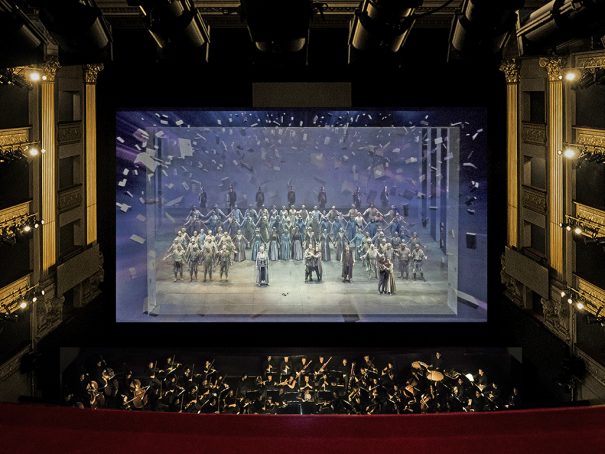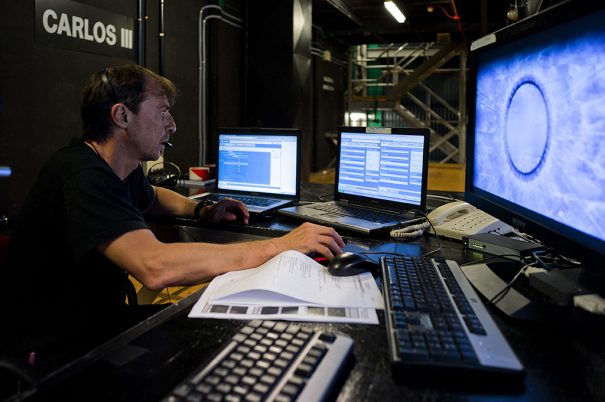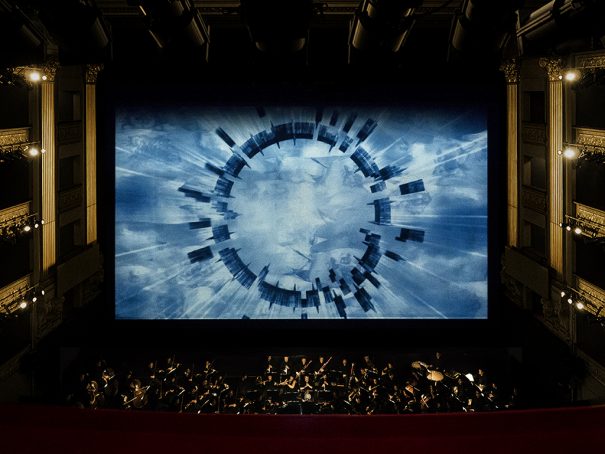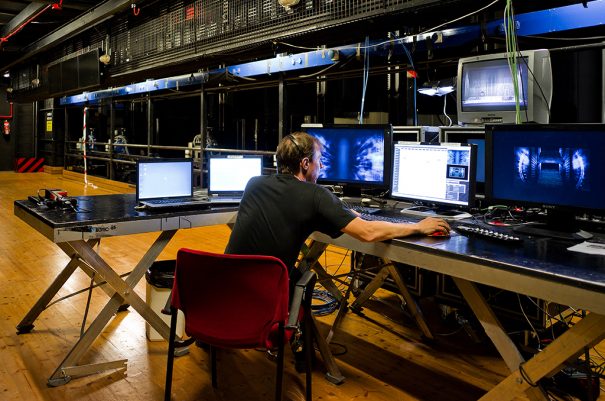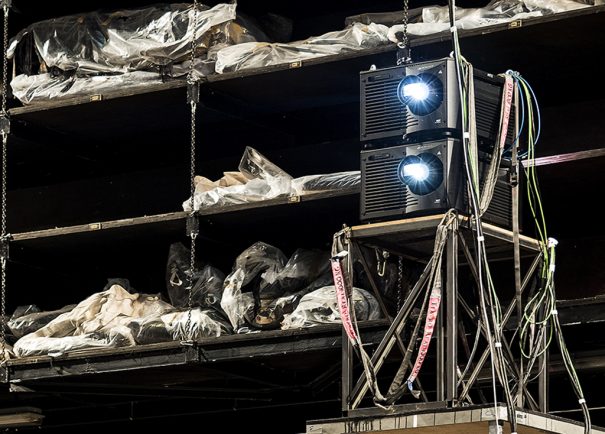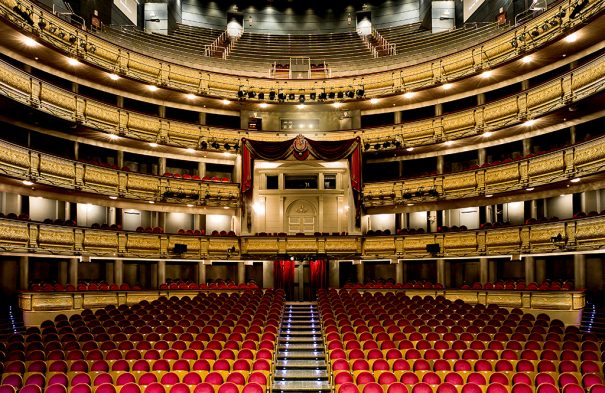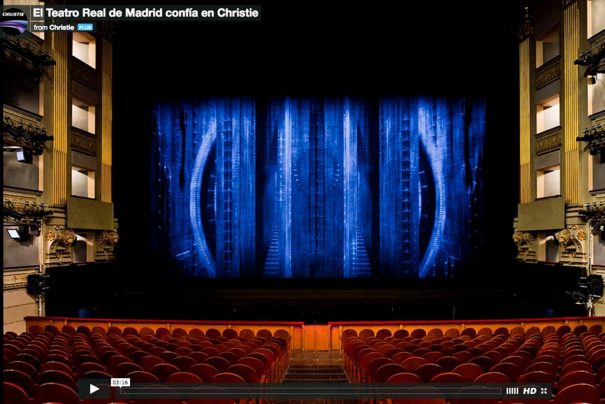El Teatro Real lleva sus escenografías a una nueva dimensión con los proyectores de Christie
Las imágenes en alta definición proporcionadas por los proyectores Roadster HD20K-J han tenido un papel estelar en la ópera Fidelio, que se ha representado durante un mes, creando unos espectaculares efectos 3D a través de una mezcla de audiovisual y realidad que sumerge al espectador en la propia obra.
La tecnología audiovisual ha entrado con fuerza en el entorno escenográfico, desplazando a los grandes elementos escénicos que antes cumplían un papel clave en la ópera. Así lo ha visto el Teatro Real de Madrid, conocido por su exigencia en el empleo de las tecnologías más innovadoras, que este año ha adquirido tres proyectores Christie Roadster HD20K-J para utilizar en las producciones que se representan en sus espacios.
El Teatro Real es el centro de la ópera de Madrid y en la actualidad uno de los más importantes del mundo, acogiendo en su escenario a los mejores artistas líricos y escénicos del momento. Fue inaugurado en 1850 y ofrece unas 180 funciones de ópera y ballet por temporada.
“Históricamente, la ópera se ha caracterizado por tener producciones con grandísimos decorados corpóreos y grandes iluminaciones. Era verdaderamente magnífico el gran volumen de materiales que se movía en las escenografías. Pero en la actualidad, con la irrupción de los medios audiovisuales, estamos viendo que cada día más esas escenografías han pasado a ser virtuales. Es decir que con la imagen conseguimos casi el mismo efecto corpóreo que antes venía en nueve camiones”, comenta Fernando Valiente, jefe de Audiovisuales del Teatro Real.
“Esto nos hizo pensar que sería muy positivo hacer una inversión en proyectores de alto rendimiento para poder tener cubierta la mayor demanda de audiovisuales que sabemos que va a venir a futuro y que nos permitirá dar un servicio de mayor calidad a todas las producciones”, continua explicando F. Valiente.
Con este objetivo, el Teatro Real convocó a tres de las principales marcas del sector invitándolas a que realizaran demostraciones de sus equipos en el rango de los 20.000 lúmenes. “La prueba se hizo en el propio teatro con las mismas señales y condiciones luminosas para todos, y los de Christie demostraron ser los equipos más fiables, robustos y versátiles”, recuerda Juan José Pérez, consultor de Proyectos de Charmex, partner de Christie que estuvo a cargo de la operación a través del distribuidor Elenco.
“Los proyectores Christie fueron los que más músculo tuvieron y mostraron mucha fiabilidad y una gran robustez de funcionamiento, con el software más sencillo y fácil de manejar y con un volumen ajustado, lo cual era muy importante por el reducido tamaño de nuestra cabina”, corrobora Fernando Valiente.
El Teatro adquirió tres Christie Roadster HD20K-J, un proyector de tecnología 3DLP, resolución HD 1920×1080 y 20.000 lúmenes. Los equipos han sido utilizados en distintas funciones a lo largo del año, pero acaban de tener un papel estelar en la ópera Fidelio (la única compuesta por Beethoven), que se representó en el teatro durante casi un mes.
Se trata de una producción procedente del Palau de les Arts Reina Sofía (teatro de la ópera de Valencia) que transcurre en una prisión a las afueras de Sevilla y que tiene una concepción escénica compleja, cargada de simbolismo, despojada de elementos escénicos ornamentales y en la que el apoyo audiovisual es decisivo para reforzar diferentes aspectos de una trama que encierra en sí misma varias tramas.
Las proyecciones en alta definición son uno de los puntos fuertes de esta producción, creando unos espectaculares efectos 3D a través de una mezcla de audiovisual y realidad que sumerge al espectador en la propia obra.
Para hacerlo posible se realizaban sobre el escenario dos proyecciones simultáneas de animaciones con 4 Christie Roadster HD20K-J. El teatro alquiló el cuarto proyector a la empresa Elenco. Dos de los proyectores, dispuestos en dual en una cabina de proyección a una distancia de tiro de 25 metros, realizaban una proyección frontal de forma constante sobre un tul semitransparente.
Los otros dos Roadster, montados también en dual en una carra instalada detrás del escenario, hacían retroproyección sobre cuatro pantallas ubicadas a distintos niveles, a una distancia de tiro de entre 13 y 22 metros.
Esta doble proyección creaba una escenografía corpórea superponiendo imágenes, un juego entre lo físico y lo virtual que dotaba de una gran profundidad al escenario y lograba así el efecto tridimensional.
La relación de aspecto era de 16:9 y se iba cropeando la imagen en función de los tamaños de pantalla. La más grande era de 17×9,30 metros y la más pequeña de unos 16 metros de ancho. La resolución utilizada fue HD 1080i.
“La verdad es que hasta nosotros, que tenemos mucha experiencia con puestas en escena usando vídeos, nos ha impresionado lo bien logrado que está el efecto 3D que se consigue con la combinación de las proyecciones trasera y frontal. De hecho, hay un momento mágico en el que distintos elementos de la escenografía salen virtualmente del escenario hacia el público haciendo que el espectador se eche para atrás en la butaca, algo realmente sorprendente”, añade Valiente.
ILS, sistema inteligente de lentes
En la retroproyección de Fidelio destaca el sistema inteligente de lentes de los Roadster, el ILS, que se ajusta automáticamente las imágenes al tamaño de la pantalla y mantiene la alineación en aplicaciones con pantallas movibles de diversas relaciones de aspecto.
“El ILS nos permitía ajustar de forma automática el foco y el zoom en cada una de las cuatro pantallas de la proyección trasera. Esto es muy importante cuando trabajas en dual porque al cambiar la superficie de proyección se pierden los ajustes y, si no tienes el ILS, tienes que hacer los reajustes manualmente, con todas las complicaciones que ello conlleva”, afirma el jefe de Audiovisuales del Teatro Real.
El ILS de los proyectores de Christie solventó el problema que se planteó en otros teatros donde se representó anteriormente la obra, que tenían que desplazar físicamente la carra con los proyectores cada vez que había un cambio de pantalla.
Para gestionar las proyecciones de Fidelio, el Teatro Real utilizó el sistema Watchout de Dataton. Las señales de vídeo se enviaban a los proyectores mediante cables de fibra óptica. También se usó un emulador Edid de Extron para gestionar automáticamente el protocolo de comunicación entre los dispositivos conectados, así como un conversor AJA de DVI a HDSDI, que es la señal de transporte interno en el teatro.
Ya ha pasado un tiempo desde que los proyectores Christie están funcionando en el teatro y las sensaciones de su Departamento de Audiovisuales no pueden ser mejores. “La verdad es que estamos teniendo una experiencia muy positiva con los equipos, hemos quedado encantados con el servicio brindado por Christie y por Charmex y confiamos en que en un futuro podamos ir ampliando nuestro parque de proyectores con Christie”, concluye Fernando Valiente.
Te gustó este artículo?
Suscríbete a nuestro RSS feed y no te perderás nada.
• Sección: Casos de estudio, Control, DESTACADO, Distribución señales, Producción, Proyección



